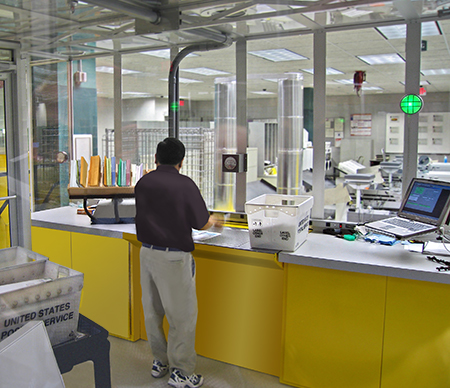ASAP III Mail Screening
Low operating costs, rapid processing.
Next-generation mailroom screening has arrived.

Introducing the ASAP III System for CBRNE mail screening. ASAP III is the successor to our venerable ASAP II system, which has been the industry standard for CBRNe mail screening since 2003.
How is ASAP III different? The new ASAP III system slashes testing costs and eliminates delays, and can identify more biothreat pathogens than ever before - up to eight simultaneously.
Traditional mail screening systems use batch processing to test all incoming mail for contamination. This method is effective, but uses costly consumables every day and slows down mail delivery.
ASAP III reduces the need for testing from multiple times per day to once or twice per month - meaning huge cost savings.
Minimal Testing, Lower Costs
ASAP III uses UV-based biodetection to determine whether testing is indicated. Unnecessary, expensive testing is avoided, and mail continues through the system without delay.
Fully Automated and Easy to Use
ASAP III is designed to be operated by general mailroom personnel. Fully automated, it requires only minimal staff training to use.
Customized for your Requirements
ASAP III can be customized to match your testing needs, mail volume, and budget. It can be installed in a fixed location or in a trailer for mobile screening.
- Features
- Applications
- Specifications
Features
Product Features
Control Software
The customizable ASAP III system can be configured with any or all subsystems: Biological, chemical, radiological/nuclear, drugs of abuse, and explosives. All installed subsystems are integrated and monitored by CBRN International's proprietary ASAP control software.- For Windows® operating systems
- Monitors subsystems continuously
- Intuitive interface
- Quick, easy installation
Biodetector
Monitoring of 280nm UV-stimulated particle scattering and biofluorescence using photon counting electro-optics. Alarm decisions are based on algorithms that consider bioaerosol statistical behavior, bio-fluorescence intensity, and aerosol composition.
Air Sampler
- Air collection rate: 300 LPM using 30,000 hour life brushless fan.
- Particulates range: 1 to 10 um.
- Air/Liquid Concentration ratio: 72,000/min. nominal.
- Liquid inventory maintained at user- preset level independent of collection time, relative humidity, or temperature.
- Liquid inventory: 4 to 5cc, nominal; continuously adjustable under computer control.
- Make-up water: System includes 8 L distilled water reservoir that provides fresh water needs for more than 5 days.
Bioidentifier
- Identifies up to eight biowarfare agents simultaneously
- ASAP III system automatically prepares sample
- Fast: 10-25 minutes per assay
- Machine vision analyzes and reports assay results
- All fluids and reagents stored on-board
Chemical Detector
- Industry leading sensitivity & false alarm rejection
- Simple maintenance
- No consumables - low lifecycle costs
- Continuous use 24/7/365
- Extensive and customizable TIC & CWA detection
Radiation Detector
- Fast - detects in less than one second
- No special training required
- Can be integrated with x-ray machine
- Omni-directional
Explosives & Drugs of Abuse Detector
- Ion trap mobility spectrometer; analysis time=8 seconds
- Accurate: False alarm rate < 2%
Applications
Applications
- Government or corporate mail rooms
- Clean rooms
- Critical infrastructure protection
- Homeland security
- Indoor air quality
Specifications
Specifications
| Parameter | Value |
|---|---|
| Use profile: | Automated, programmed, continuous monitoring/identification of targeted toxins, viruses, bacteria, spores, industrial chemicals, explosives, drugs of abuse, and nuclear materials. Continuous or batch sample examination supported. |
| Duty cycle: | Continuous. Functional availability >99.3%. Calculated as total work time the system is functional averaged over a 90 calendar day period. |
| Air sampling rate - collector: | 300 liters/min from downdraft table or alternate sources. |
| Air sampling rate - detector: | 1.2 liters/min |
| Sample preparation: | Sample preparation for bioassay is fully automated. |
| Bioassay method: | A bioassay is only required when the bioaerosol detector observes a potential threat, typically about once per month in mail rooms. Testing is done by automatic robotic lateral flow immunoassay for up to 8 biowarfare agents simultaneously. |
| Total bioassay time to result: | 10 to 25 minutes. |
| Toxic industrial chemicals subsystem: | Ion mobility spectrometry or long baseline infrared spectrometry. Gas libraries of 15 to 40 targets, depending on technology used. Analysis time less than 10 seconds. |
| Explosives subsystem: | Ion trap mobility spectrometer; analysis time = 8 seconds |
| Nuclear materials subsystem: | Area and portal styles available. Typical specifications: 0.05 to 3.0 MeV gamma detection window. Detect 360 kBq of Cs-137 and 6 gm Pu(2); neutron detection optional. |
| Communication: | RS-232 bi-directional serial link is standard. |
| Data storage/ programmability: | Raw/processed data storage. Operating protocols are RS-232 re-programmable. | Software interface: | Windows® user interface. |
| Fluids storage: | 5-day supply of distilled water for aerosol collector. |
| Fluids storage: | 5-day supplies of buffer, disinfectant and distilled water for aerosol collector. |
| Physical size: | Varies. Usually installed as an under-counter system with video monitor on countertop. |
| Temperature range: | Operating: 5°C to 50°C; storage: -29° to 66°C. |
| Alarms: | Large green/amber status light; annunciator optional. |
| Humidity: | 5% to 95%, non-condensing. |
| Power consumption: | Less than 100 W @ 115 VAC, nominal, excluding X-ray. X-ray system requires 183-253 VAC, 50 Hz. 10 amp max. |
CBRN International reserves the right to change specifications without prior notice.


